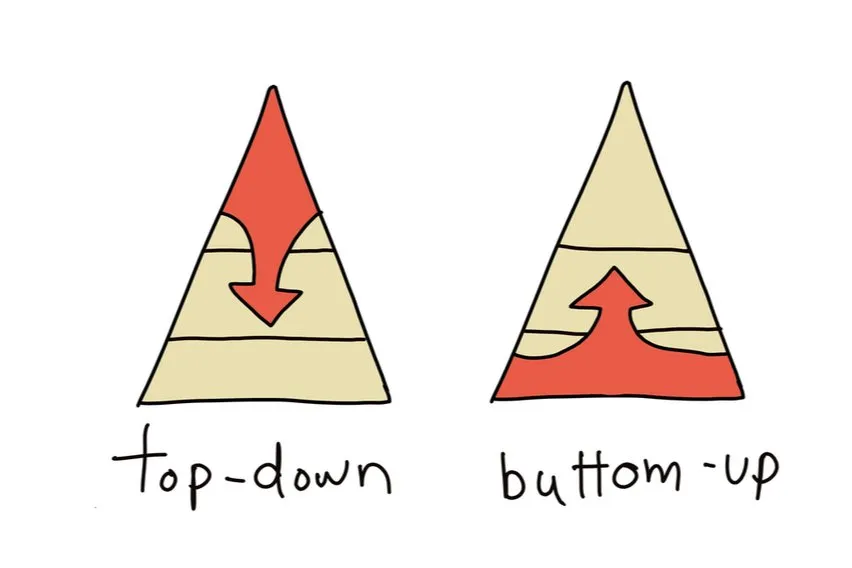Bottom-Up vs Top-Down Approach: What’s the Difference?

When starting your own business, it’s important to have a plan in place and an idea of your management style.
There are generally two most popular approaches to management.
- Top-Down
- Bottom-Up
Both of these methods provide specific benefits to you and your business.
But what are they and what is the difference between the two? And which one should you utilize to help kickstart and streamline your business management?
We’ll take a closer look at both top-down and bottom-up approaches.
Here’s What We’ll Cover:
The Pros and Cons of Top-Down Management
The Pros and Cons of Bottom-Up Management
Which Approach Should I Choose?
Top-Down Management
What Is a Top-Down Approach?
Adopting the top-down model is the most common business management style.
It is the classic hierarchical structure where the owner or CEO is at the top. It then makes its way down to the bottom rungs of the hierarchy which would tend to be the lower level employees.
It’s easiest to think of it as a pyramid.
The CEO is at the skinny tip, as there tends to only be one. As you go further down the pyramid it expands as there are more and more people filling these positions.
This carries on until you get to the bottom and most populated area, which is the rank and file employees.
In a top-down system, everything from the workplace to all of the business systems are put in place and determined by the upper management. From there, each issue is passed down the chain of command.

The Pros and Cons of Top-Down Management
The advantage of having a top-down management system is that it gives a sense of stability and structure.
It sets clear goals and expectations as the message isn’t being diluted by either a committee or multiple voices.
Some employees work better when not involved in the process of decision-making. They prefer to be given a goal and a deadline so they can go away and work to that end.
However, for top-down management to work successfully, you need to have a strong leader. This leader needs to not only motivate people but be dependable and approachable.
One of the biggest complaints from employees is a lack of strong leadership. For example, a Harvard Business Review survey showed that 58% of workers say that they would trust a stranger more than their own boss.
So for this method of management to work, you need to make sure that the leader in question is highly suitable, and can get the best out of their team.
If a team is led by a bad or dictatorial boss, then morale tends to plummet. This leads to less work being done, unhappy staff and potential collapse.
Bottom-Up Management
What Is a Bottom-Up Approach?
A bottom-up model of management shares the responsibility amongst its workers.
This means that the whole organization participates in the business and work process. The work is then sent to the higher-ups to approve.
This is a far more collaborative method that gives employees a say. They can have a valued input in how to accomplish the overall goals and objectives that are laid out.
It’s an approach that has been gaining popularity in recent years as it allows ideas to come from anywhere. So businesses are finding that they are finding more innovative solutions to various challenges.
It’s also an approach that involves a lot of trust. Upper management will assign tasks and deadlines to specialized teams. The teams are then self-directed in the process and decide amongst themselves the best way to complete each objective. This is opposed to just receiving orders and being given methods to act on.
The Pros and Cons of Bottom-Up Management
This is a perfect solution for companies that have a lot of talent within the staff base. This talent would be wasted in a top-down system as their voices would not be heard. So it’s a system that tends to be adopted in businesses with highly specialized and trained staff.
If there is a lack of strong leaders in your organization, then a bottom-up approach is a smart approach. This way your talented staff can work together as a unit to bring the end results to you as upper management.
This approach can also create a sense of togetherness and accomplishment within your staff.
Because the whole organization feels a part of the process, they are far more likely to be productive. If they all have a sense of ownership over the project and its goals, they will be more dedicated to the cause.
On the other hand, some businesses say this approach lends itself to the adage of too many chefs spoiling the broth.
When everybody’s voice is heard and considered, it can make decision-making an arduous process and can slow down the average time to complete a task
Business agility is key, so there are scenarios where a committee can slow down the process enough to allow the competition to steal a lead on you.
It’s also a system that can fall to ego issues. If everyone is putting all their effort into being heard, they may be motivated by self-interest rather than the overall goals that have been set.
This can create division and even lead to a toxic work environment.

Which Approach Should I Choose?
It can be difficult to choose which method works best for your business. Therefore it’s important for you to take stock of what is important to you, and what resources you have available.
Each business has a different set of needs that need to be met, and different resources available to them to achieve this.
Some businesses do not have the staff talent to adopt the bottom-up approach. Just as some businesses don’t have the leaders necessary to make top-down management work.
This has led to a lot of companies nowadays taking a middle-of-the-line approach to management.
These companies are looking for ways to utilize certain elements of the bottom-up philosophy. Even if they previously had a top-down dominated business.
If you have a huge pool of talent in your workforce, then maybe it is a good idea to incorporate some bottom-up methods into your business.
And if you have some strong leaders in your team that the other employees admire and respect, you can utilize that. It could be a good idea to give those employees some more responsibility by promoting them to middle management.
Key Takeaways
Both methods of management have value when it comes to running a business.
The bottom-down approach is a fantastic way to show your staff that they are valued.
Some organizations need a lot of highly educated, forward-thinking employees. For example most software and technology firms. These companies have huge incentives to approach more bottom-up methods.
Yet top-down businesses are still the most common.
Having strong leaders in both upper management, and in the workforce can only be a plus. They can help create an efficient and streamlined business.
However, we are certainly starting to see a shift.
Are you looking for more business advice on everything from starting a new business to new business practices?
Head over to our resource hub.
RELATED ARTICLES

 How to Write a Small Business Plan: 3 Top Tips & Free Sample
How to Write a Small Business Plan: 3 Top Tips & Free Sample 6 Best Daily Planner Apps to Keep You Organized
6 Best Daily Planner Apps to Keep You Organized Top 3 Weekly Timesheet Tools to Track Your Working Hours
Top 3 Weekly Timesheet Tools to Track Your Working Hours What Is a Decision Tree Analysis? Definition, Steps & Examples
What Is a Decision Tree Analysis? Definition, Steps & Examples What Is Customer Relationship Management (CRM)?
What Is Customer Relationship Management (CRM)? 8 Areas of Improvement for Employees & The Workplace
8 Areas of Improvement for Employees & The Workplace